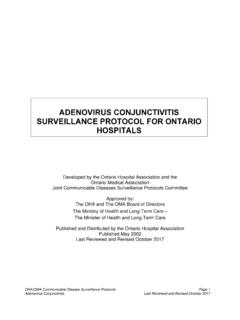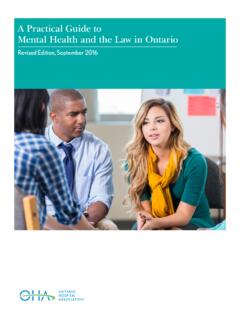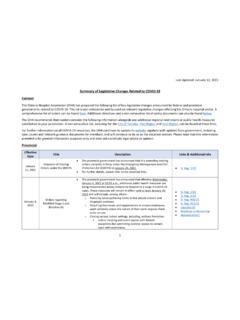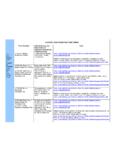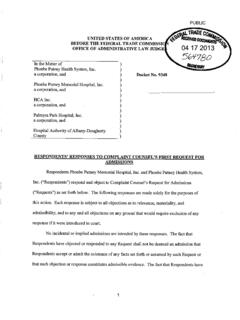Transcription of Form 1 Assessments Under the Mental Health Act Frequently ...
1 Form 1 Assessments Under the Mental Health Act Frequently Asked Questions This is an update to the April 2013 OHA Backgrounder: Form 1 Assessments Under the Mental Health Act, developed with guidance from Borden Ladner Gervais LLP. This FAQ is intended to clarify various practices involving Form 1s, including the use of telemedicine services, the impact of further clinical examinations on a Form 1, and transition from police custody to care by the clinical care team when someone is brought to the emergency department (ED) with Mental Health concerns. An overview of the relevant statutory provisions is set out below, followed by updated comments on these issues. Note that this resource provides general information only and is not intended as, nor should it be construed as, legal or professional advice or opinion.
2 Overview Statutory Authority for a Form 1 A Form 1 is an application by a physician for a person to undergo a psychiatric assessment to determine whether that person needs to be admitted for further care in a psychiatric facility, as an involuntary or voluntary patient, or if they should be discharged. The statutory authority for a Form 1 is found in section 15 of the Mental Health Act (MHA). The physician who completes the application need not be a psychiatrist; however, the physician must have personally examined the person within the seven days prior to completing the Form. The examination is not something that can be delegated. In addition to their own observations, physicians are entitled to rely on the reports of others about the person but must distinguish between the two and document accordingly.
3 There is no requirement for the examination to take place in a hospital. It can take place in any environment in the community, a physician s office, a clinic, or in an ED. Form 1 Assessments Under the Mental Health Act Frequently Asked Questions Box A and Box B Criteria and Effective Date There are two sets of criteria for a Form 1 which are set out in the MHA. These are often referred to as Box A and Box B as this is how they are reproduced on the Form 1 document. Box A is known as the serious harm test and is derived from the language of subsection 15(1) of the MHA. Box B provides the authority to involuntarily admit incapable persons who have suffered from recurrent Mental disorders that have responded to treatment in the past. Subsection 15( ) of the MHA is the statutory basis for the Box B criteria.
4 A Form 1 takes effect on the date that it is signed by the physician. To sign a Form 1, the physician must have examined the person who is the subject of the application within the last seven days. Once signed, the Form 1 is effective for seven days and provides authority to transfer the individual to a psychiatric facility where they may be detained, restrained, observed and examined for no more than 72 hours. Frequently Asked Questions Can examinations to complete a Form 1 be completed via the Ontario Telemedicine Network ( OTN )? Physicians may complete examinations remotely, including through the OTN. The MHA requires the physician to examine the person, but there is no specific requirement that this be in-person. Physicians must use their professional judgment to determine the appropriate way to conduct an examination for a particular person.
5 Some of the things to consider in determining whether to use the OTN or another option may include: Is access to the system available? Is the person able to participate in the examination ( , can the person be safely managed if they have to move to access the system)? Does the access provide a confidential environment for the examinations? Is the connection confidential, with information security safeguards? Is there a plan in place to manage an adverse event or emergency during the examination? Form 1 Assessments Under the Mental Health Act Frequently Asked Questions Practically, physicians must also consider the alternative how would the examination occur if not via the OTN? The use of the OTN for clinical consultations, Assessments and examinations, including psychiatric examinations, often allows for more timely access to care and minimizes any need for the patient to travel out of their home community for the assessment.
6 The use of technology to facilitate access to care is not limited to the OTN and these comments may be applicable to other networks / systems. Can psychiatric Assessments by a psychiatrist be completed via the OTN? As with an examination to determine whether a person meets the criteria for a Form 1, a psychiatric assessment, consultation, examination or period of observation may be completed by a psychiatrist via the OTN. Considerations regarding the appropriateness of the OTN for this purpose may need to be discussed between Health care providers at both facilities, namely, the facility where the person is being detained for the purpose of obtaining a psychiatric assessment and the facility where the psychiatrist is located. The considerations listed above for conducting an assessment for the purposes of initiating a Form 1 are relevant here.
7 Again, the use of technology to facilitate access to care is not limited to the OTN and these comments may be applicable to other networks / systems. Can a Form 1 be cancelled ? Following a patient s examination, a physician may decide that the Form 1 is no longer clinically indicated and cancel or discontinue the application for psychiatric assessment. Practically, this occurs when the patient is further examined by a physician, other than a psychiatrist, who concludes that the person no longer meets the criteria for the Form 1; therefore, a psychiatric assessment to determine if the person may require admission to a psychiatric facility for further treatment and care is no longer necessary. Form 1 Assessments Under the Mental Health Act Frequently Asked Questions Deciding that a person no longer meets the criteria for a Form 1 may be made in consultation with a psychiatrist via the OTN.
8 If a physician concludes that the person does not require an in-patient assessment for up to 72 hours, that physician can cancel the Form 1. In some situations, consultation with a psychiatrist may be a key element for deciding to cancel a Form 1. The physician should document any decision in the patient s chart. If a psychiatrist is completing the examination, this presumably would be the psychiatric assessment contemplated when the Form 1 was issued. The options available to the psychiatrist are summarized above: admit as a psychiatric patient, or discharge if further care is not required in a psychiatric facility. Any clinical assessment, examination or consultation should be documented in the chart. Copies of the Form 1, and Form 42 if applicable, should also be in the chart. In addition to the clinical note, the physician who determines that the patient no longer meets the criteria for the Form 1 should note this in the corresponding order.
9 The clinical reasons for this decision, as well as other decisions about the patient s treatment and care should be documented in the chart. The person will be discharged from the hospital in accordance with a physician order. Are original Form 1s necessary? To better ensure that patient care is provided as efficiently as possible, where the Form 1 was completed at another location or using telemedicine services, receiving hospitals are encouraged to accept a Form 1 through fax or other secure electronic transfer. Any communication of personal Health information must be in accordance with accepted privacy practices. In what situations may a person be detained, restrained or confined at a hospital? Regardless of the manner in which a person arrives at the hospital, the MHA provides designated psychiatric facilities with authority to detain or restrain a person for the purposes of a psychiatric assessment (Form 1 or Form 2) and, in certain situations, in the course of their treatment and care as a psychiatric patient Under the MHA.
10 An individual brought to a hospital by police Under section 17 of the MHA, or without a Form 1 or Form 2, is not automatically a psychiatric patient and there is no automatic authority for the person to be detained or restrained in the hospital. Form 1 Assessments Under the Mental Health Act Frequently Asked Questions The Patient Restraints Minimization Act and common law, described in more detail below, are applicable to those waiting for assessment or care in an ED as well as those who are not psychiatric patients Under the MHA this includes patients who may pose an imminent risk of harm to themselves or others as a result of a physical illness, such as delirium, as well as patients brought to a hospital by police Under section 17 of the MHA. The common law provides support for Health care providers to restrain or confine a person when immediate action is necessary to prevent serious bodily harm to the person or to others.

